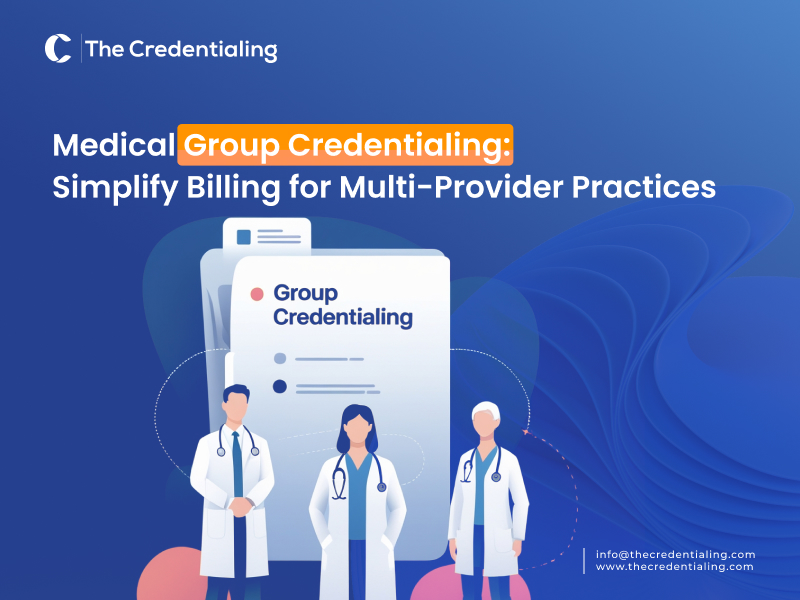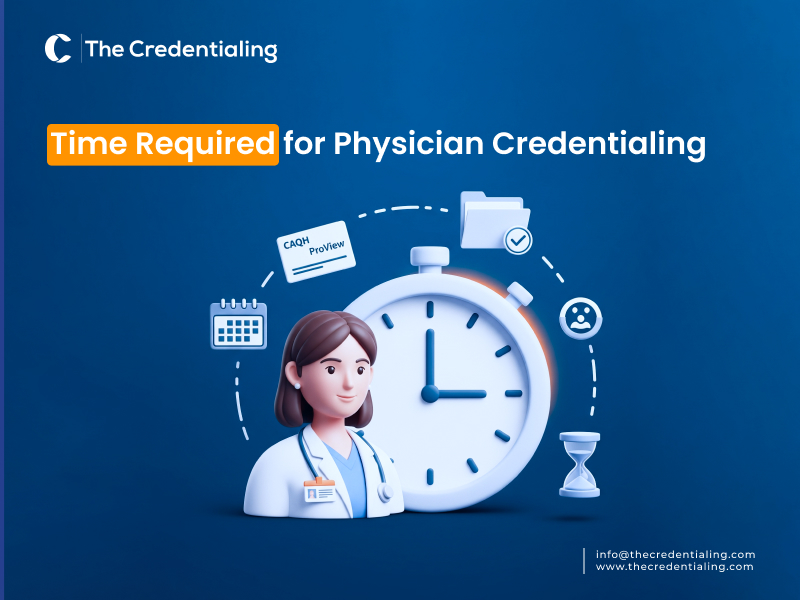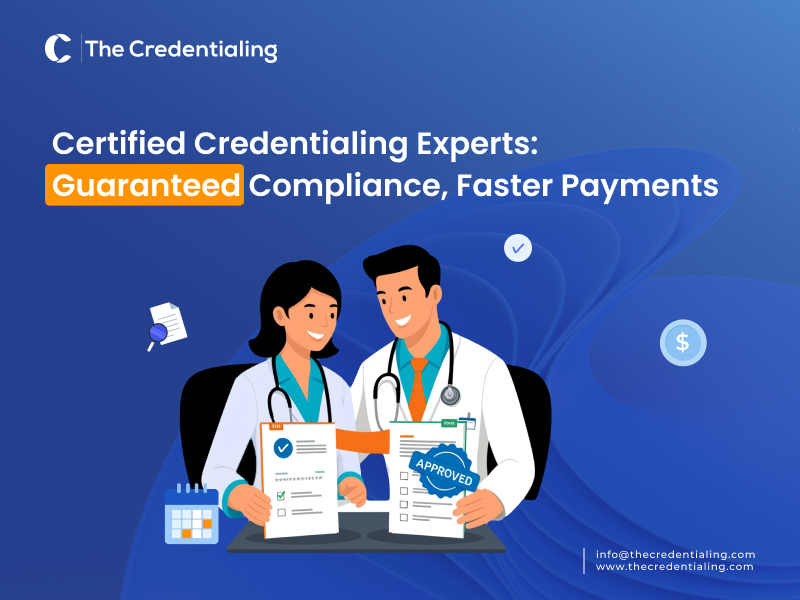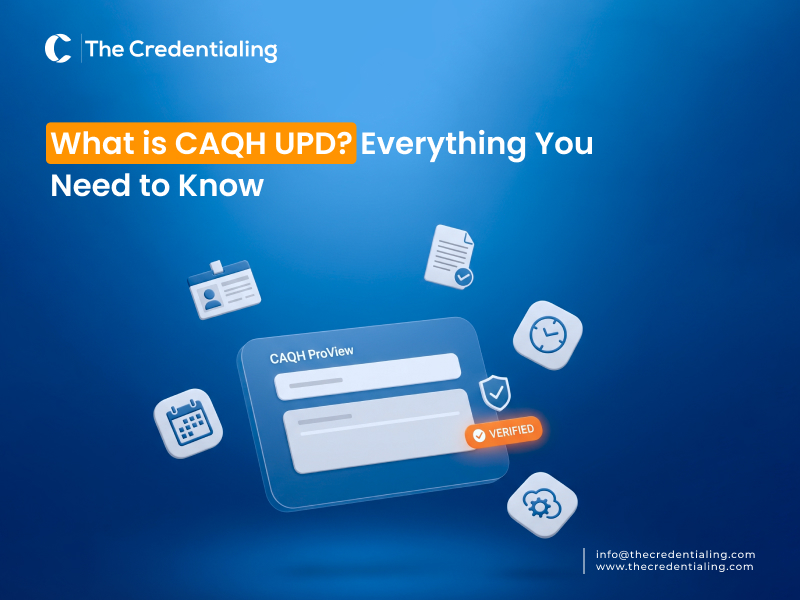Medical Group Credentialing: Simplify Billing for Multi-Provider Practices
Streamline medical group credentialing in the USA. Simplify billing, ensure compliance, and boost revenue for multi-provider healthcare practices.
Schedule Free Demo Today
Credentialing is the core to healthcare providers in terms of ensuring their eligibility to perform care, while practices are sustained by having the care providers with the necessary qualifications. Every medical facility, small or extensive, hospital or ambulatory surgery, or any other type of healthcare organization must verify its providers’ credentials before hiring to practice care, along with assuring the reverification every two years as per the standards.
Each type of process, such as credentialing and privileging in healthcare, serves a different purpose. For instance, privileging focuses on the scope of procedures that a provider performs. However, medical credentialing services has a direct impact on how a provider bills a patient for insurance reimbursement.
As for multi-provider credentialing, it involves practice rather than individuals that is supposed to get credentialed and approved to bill under a single contract by the insurance company. Whereas, individual providers are considered the “rendering providers” under that contract.
When compared to medical credentialing, group credentialing or collective credentialing comes with its own set of challenges impacting the staff’s speed and administrative workflow. Yet, maintaining the process efficiency is utmost for practices considering the perks of higher reimbursement potential. According to Medallion’s 2024 report, 46% of healthcare organizations report revenue losses due to delayed or inefficient credentialing, while 57% face high staff turnover in enrollment teams.
Furthermore, what’s more stressful is that 52% still rely on manual credentialing workflows, compounding delays and administrative burden. However, having the right hand in the process can speed up and simplify tasks such as following the group provider credentialing checklist.
On top of that, this guide offers explanations of key types and best practices to streamline billing for multi-provider practices at a glance. Learn how medical group credentialing can be a breeze for stabilizing revenue levels.
Individual Vs. Group Credentialing: What Sets a Multi-Provider Credentialing Apart?
In general terms, credentialing is a process of provider verification that sets the scale for the entity to get enrolled with insurance payers. All types of credentialing processes follow similar steps and cycles, such as verification of provider credentials, verification of insurance, and provider enrollment.
Individual credentialing requires healthcare providers to have a separate verification of their credentials through steps including obtaining an NPI, enrolling with CAQH, applying to insurance companies, completing verification, and signing a contract.
On the other hand, medical group credentialing follows registering the business with insurance panels after obtaining an NPI, applying for a tax ID (EIN), enrolling each provider with CAQH, submitting applications separately, and obtaining group contracts. Here are the key essentials that set group credentialing apart from provider credentialing:
-
Group practice is credentialed as a whole, requiring an Employer Identification Number (EIN) and a National Provider Identifier Number (NPI).
-
The practice obtains group contracts with insurance companies to bill under a single agreement.
-
Individual providers are considered “rendered providers” within the group’s contract.
-
Documentation requirements vary as the group needs to provide a signed W-9, each provider’s license, proof of malpractice insurance, and the group’s tax ID.
-
Each provider in the group needs their own CAQH profile.
-
The benefits include that adding a new provider becomes easier within the group’s contract.
-
Extended groups can effectively communicate with insurance companies to increase reimbursement potential.
-
Group credentialing ensures centralized billing, claims processing, and insurance-related tasks to add operational efficiency.
-
New providers can be added within the group without credentialing to start from scratch.
Step-by-Step Credentialing: A Backbone of Timely Medical Billing
The answer to the question “What is credentialing in medical billing?” is, it is a multi-step process that verifies a healthcare provider’s qualifications to authorize these entities for care and billing. The sequential procedure of credentialing in medical billing includes the following steps that will help simplify the process and stay tuned:
-
Submitting the provider application after collecting all the necessary information that details the provider data and the ability to treat patients.
-
Once the application is submitted, the next step is “primary source verification,” which includes checking the provider’s education, degree and licenses, training and residency programs, and past and current employment status.
-
Examining deficits in applications by the insurance companies. However, the research suggests that only 15% of applications are complete, with the rest lacking critical information.
-
Common deficits are missing work history and current work status, physician’s practice and effective date with the practice, hospital privileges and covering colleagues and attestation and malpractice insurance details.
-
Payer timelines vary for credentialing, as the standard period is three months. However, issues occur that delay the process. Allowing additional time is necessary to address malpractice and follow up regularly with the insurance company.
-
Healthcare providers have access to the CAQH to keep their data up to date and maintain credentialing. The Universal Provider DataSource (UPD) is a part of CAQH that helps providers stay efficient with the verifications.
-
Healthcare providers also need to stay current with varying state laws in credentialing to ensure compliance. To ensure adherence to state-specific laws for credentialing, the Medical Group Management Association (MGMA) is a considerable source.
-
Once these specifications are complete, the insurance company assures participating providers of a contract. This is an official statement for the professionals to provide care and bill patients.
Some Other Tips to Streamline Credentialing:
-
Integration between credentialing and billing systems.
-
This will help you save practice from delays in claim submission and reimbursement.
-
Maintain ongoing credentialing with regular updates every 2 or 3 years or as per the preferences of regulatory bodies.
-
Keep your credentialing data secure in a centralized platform to simplify audits, renewals and future payer interactions.
-
Use automation software to speed up the process and stay away from manual errors.
-
Create and maintain a checklist for all providers to stay consistent and document readiness.
-
Assign a dedicated credentialing coordinator to monitor the process and payer communication.
-
Set reminders for recredentialing deadlines to stay safe from expirations and avoid revenue disruptions.
The Role of a Credentialing Specialist in Multi-provider Practices:
Acknowledging the complexity of each step of the process, such as payer enrollment usually takes 30+ days to complete, your practice needs a credentialing specialist. A 2024 report by the Medallion states that 30% of organizations spend over eight business days just gathering provider data, delaying billing readiness.
However, a seamless integration between credentialing and billing systems is important, as 46% of organizations report revenue loss due to delayed or disjointed workflows. Usually, the US runs a medical credentialing salary around $ 52,306, but a credentialing specialist, who typically earns between $45,000–$60,000 annually, plays a critical role in coordinating these efforts, reducing delays, and ensuring compliance.
For your multi-provider practice, credentialing efficiency avoids costly gaps in reimbursement and speeds up revenue cycles. Moreover, automation is the key driver of process success as it reduces additional administrative workflow while improving turnaround times.
Why Group Credentialing in Medical Billing is Challenging for Healthcare Practices?
Group provider credentialing is challenging due to its scale, complexity, and administrative requirements. When practice needs to manage multiple providers at the same time, there is a critical need for strict coordination of documentation, varying payer requirements, and strict timelines. Below is a breakdown of some key notes:
-
Credentialing for providers in a group may extend to six months beyond the standard 60 to 90 days.
-
Such a timeline delay affects providers’ care and ability to take on new patients, along with reimbursement delays.
-
Compliance requirements are complicated, considering the state-specific laws and regulatory changes
-
At times, providers skip the updates, resulting in misunderstandings and errors, further complicating the flow.
-
Group provider credentialing deals with excessive paperwork and documentation management.
-
A reported 21% of credentialing teams’ working hours are spent on verifying details, creating process inefficiency.
-
The data shows that a significant 85% of credentialing approval requests contain missing or incorrect information.
-
Neglect of these issues leads to accuracy and delays, compliance risks, and loss of revenue.
-
A significant shortfall of credentialing staff, reported around 35%, is a big hurdle in credentilaing departments for managing the workflow.
-
These gaps slow down the important procedures and delay patient care. Hence, your practice needs a solid solution to manage your practice productivity while ensuring a flawless adjustment.
Simplified Group Credentialing with Tech-Driven Solutions: Areas Provider Credentialing Software Can Improve!
The emerging tech solutions can be a key to addressing the key hurdles of group provider credentialing. Consider the areas in the credentialing process where you can use provider credentialing software to experience unmatched efficiency.
For instance, document management, workflow optimization, and effective communication among all the stakeholders.
Electronic Application Management
Online submission of group provider credentialing will save you a great time and resources. Unlike manual application handling, electronic methods ensure safety and an error-free process while securing the data.
The safe data entry ensures that you will not compromise on disclosing sensitive provider information. Moreover, information provision is in real time with prime security and process transparency.
Automated Data Gathering
Innovative provider credentialing software automates the critical task of provider data collection and verification. This is a reason why a majority of healthcare providers rely on automation in data collection rather than paperwork or manual data entry.
Automation through medical staff credentialing software helps providers in speeding up the process while ensuring an error-free workflow.
Centralized Data Management
By using automation software in credentilaing, practices can ensure all scattered data is stored in a single platform through a secure digital database. This not only offers easy access to healthcare organizatins and providers but them can quickly retrieve the information for verification when needed.
As a result, healthcare providers can effectively be credentialed without the disruptions and delays due to lost data.
Increased Efficiency in Verification
Using tech solutions in group credentialing has advanced the process as physicians and practices have easy access to databases that offer real-time updates on provider credentials such as certifications, licenses, and other disciplinary actions.
Medical practices having access to updated provider data also reduce the likelihood of hiring providers with outdated credentials. Ensuring the availability of qualified providers with updated credentials can improve patient care and enhance the overall quality of healthcare.
An Effective Communication
Healthcare practices, especially credentialing firms, are in dire need to have effective modes of communication to achieve the target goals, such as ensuring the credibility of care providers, leading to safe billing and insurance reimbursement.
Tech-driven solutions offer various end-to-end encrypted messaging systems to enhance communication. For instance, healthcare providers can avail status updates and requests for documentation to improve overall credentialing efficiency and reduce disruptions in the process workflow.
Complex Compliance Management
Staying up to the ever-changing requirements in healthcare is complex unless practices follow a provider credentialing software solution that facilitates compliance with state and federal regulations. By using automation, the system updates the process to ensure ongoing compliance with regulations. Consequently, practices get the safety from hefty penalties while maintaining the reputation level.
Till now, your knowledge and interest in automated solutions rather than manual effort in managing group credentialing are at an escalating level. However, the availability of automation and digital tools isn’t sufficient to do justice. Expert handling is essential to reach the turnouts! So, we will show you the right direction. Explore TheCredentialing, an expert and all-inclusive credentialing solution provider.
Wanting to Advance Your Group Credentialing? Explore TheCredentialing Marketplace for Best Solutions!
TheCredentialing is an innovative firm to help your practice with all types of credentialing requirements. Our medical credentialing services include credentialing and enrollment, revalidation, compliance, and licensing for all types, such as government, commercial, Medicaid or Medicare. At TheCredentialing, professionals are operating with extensive solutions, credentialing expertise and automation support.
Explore TheCredentialing portal that helps your individual or group medical credentialing services to reduce admin work, stay compliant, simplify renewals and secure data management across all intervals. These professionals believe manual credentialing means a 26% rate of rejections.
Hence, TheCredentialing is an all-inclusive firm, bringing your practice’s providers counted among the top qualified, having an extended insurance network and many happy patients. Our only purpose in serving credentialing is to ensure practices have the right hands to manage their reimbursement, leading to healthier revenue levels.
Sit Back and Relax! Let The Pros Handle Credentialing For You!
thecredentialing has built a strong portfolio while providing credentialing services to clients over the years. Our service includes helpful features that you won’t find anywhere else.
Schedule Free Demo Today!

